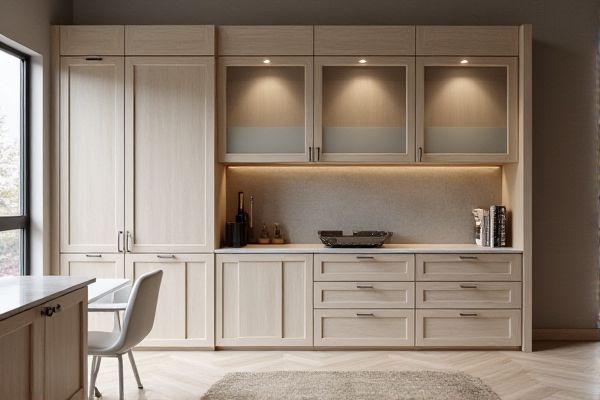
Roller cabinets offer mobility and convenient access to tools by easily moving them around your workspace, while static cabinets provide a sturdy, stationary storage solution with greater capacity and durability. Explore the rest of the article to understand which option best suits your tool organization needs.
Table of Comparison
| Feature | Roller Cabinets | Static Cabinets |
|---|---|---|
| Mobility | Portable, equipped with wheels for easy movement | Fixed in one location, no wheels |
| Use Case | Ideal for workshops, garages, and mobile tool storage | Suitable for stationary tool storage in workshops and offices |
| Size | Generally smaller and compact | Typically larger with more storage capacity |
| Weight | Lighter due to portability design | Heavier and more robust for stability |
| Security | Often includes locking mechanisms, but riskier during movement | More secure and stable locking options |
| Cost | Moderate to high, depends on mobility features | Generally lower cost, focusing on storage capacity |
Overview: Roller Cabinets vs Static Cabinets
Roller cabinets offer mobility and versatility with built-in casters, allowing easy repositioning in workshops, while static cabinets provide stable, stationary storage solutions ideal for fixed setups. Roller cabinets typically feature durable wheels and ergonomic handles, enhancing accessibility and convenience for tool organization on-the-go. Static cabinets emphasize robust construction and higher weight capacity, making them suitable for heavy-duty storage in dedicated workspaces.
Key Features of Roller Cabinets
Roller cabinets feature heavy-duty casters for easy mobility and enhanced workspace flexibility, unlike static cabinets which remain stationary. These cabinets typically include multiple drawers with ball-bearing slides for smooth operation and robust storage options tailored for tools and equipment. Their durable steel construction combined with lockable drawers ensures security and longevity in demanding workshop environments.
Key Features of Static Cabinets
Static cabinets offer enhanced durability with solid, stationary construction designed to withstand heavy tools and equipment. Featuring multiple fixed shelves and secure locking mechanisms, they provide organized storage without the mobility of roller cabinets. Your workspace benefits from their stable, non-slip base that ensures safety and reliability in busy environments.
Mobility and Flexibility Comparison
Roller cabinets offer superior mobility with heavy-duty casters that allow you to easily move tools and equipment across your workspace, enhancing flexibility during projects. Static cabinets remain stationary, providing a more stable storage solution but limiting access to tools in different locations. Choosing between roller and static cabinets depends on whether your priorities lie in dynamic tool accessibility or permanent, space-saving organization.
Storage Capacity Differences
Roller cabinets provide enhanced storage capacity with mobile drawers that allow access to tools from multiple angles, optimizing workspace organization for mechanics and technicians. Static cabinets offer a fixed structure with typically larger overall volume but limited accessibility, making them ideal for bulkier items or stationary tool storage. Comparing storage capacity, roller cabinets maximize efficiency through compartmentalized, movable sections, whereas static cabinets prioritize stable, high-capacity storage in a single location.
Space Utilization and Organization
Roller cabinets maximize space utilization by offering mobility, allowing you to easily rearrange your workspace and access tools from multiple angles. Static cabinets provide stable, stationary storage with fixed compartments designed for organized tool placement and long-term storage. Choosing between them depends on your need for flexibility versus dedicated, compact organization within a fixed area.
Durability and Build Quality
Roller cabinets typically feature reinforced steel frames and heavy-duty casters, providing enhanced mobility without compromising durability, making them ideal for dynamic workshop environments. Static cabinets are constructed with thicker panels and robust welds, ensuring superior structural strength and long-lasting stability in fixed locations. Choosing the right cabinet depends on your need for portability versus maximum build quality to withstand heavy tool storage.
Safety and Security Considerations
Roller cabinets offer enhanced mobility, allowing you to quickly relocate tools and materials while preventing unauthorized access through lockable drawers and sturdy construction. Static cabinets provide superior stability and are less prone to tipping, making them ideal for safely storing heavy or hazardous equipment in a fixed location. Both cabinet types can be equipped with advanced locking mechanisms to ensure tool security, but careful placement and maintenance are key to maximizing safety in any workspace.
Ideal Use Cases for Each Cabinet Type
Roller cabinets excel in environments requiring frequent tool mobility and quick access, such as busy workshops and on-site mechanic jobs, due to their sturdy wheels and portability. Static cabinets are ideal for fixed workstations or storage areas where space optimization and heavy-duty storage without movement are priorities, offering durability and steady organization. Choosing the right cabinet depends on whether your workspace demands mobility or a permanent, reliable storage solution.
Cost Analysis and Value for Money
Roller cabinets typically cost more upfront than static cabinets due to their mobility features and durable casters, but they offer greater flexibility for workshop layouts and ease of access to tools. Static cabinets provide a more affordable storage solution with a solid, stable structure, ideal for fixed workstations where mobility is unnecessary. Your choice should consider long-term value, as roller cabinets enhance workflow efficiency, potentially reducing downtime and boosting productivity, which may justify the higher initial investment.
 homyna.com
homyna.com